When I started this series I mentioned that the Incredible Hulk’s greatest villain was returning. It caused me to start talking about my theory on rival design. For people new to character design I advised if they were stuck on creating villain then they should try making an evil mirror version of the hero. For example the Abomination was the evil counterpart to the Hulk, and Bizarro was the same for Superman. These types of enemies worked well all throughout pop culture. I also mentioned that the most interesting rivals had asymmetrical designs. They did not have a similar group of skills or abilities as the protagonist. Even opponents that were physically inferior could be considered the most dangerous of rivals. Lex Luthor was a regular human compared to the Kryptonian Superman, yet for over 80 years he was considered the greatest opponent.
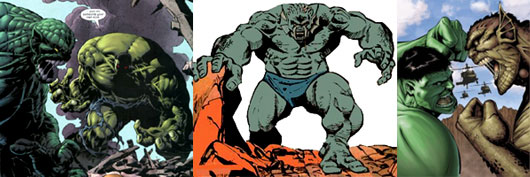
For the Hulk I mentioned that General Thaddeus "Thunderbolt" Ross was similar to Lex Luthor. Introduced in the first issue of the Hulk way back in 1962 he was a military leader that managed to be very problematic for the most powerful monster in the Marvel U. Then I talked about how not every author understood the characters that they were assigned, and ended up changing them to fit their own narrative. Jeph Loeb was a writer that gave Ross powers, and turned him into the Red Hulk in 2008, forever changing their dynamic in Marvel continuity. He then went on to give his daughter a gag comic where she added a Blue Hulk as well. I thought it was a bad idea then, and still think so to this day. If I were to give all the flowers to a writer that went in blind, and managed to continue building the legend of the Hulk then I would go with Peter David. Mr. David had written all sort of stories, and characters over the years. When he was hired at Marvel his dream was to write the Spider-Man books. He said he would have been happy with any book he was given, as long as it wasn’t the Hulk.
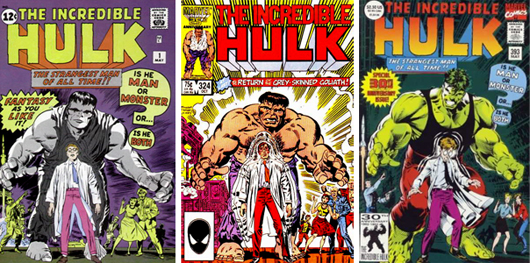
He thought that character had no dimension, and nothing interesting about him. Yet that was exactly the book he was told to write for in the late 1980’s. He didn’t complain or change the character to fit his preconceived notions. Instead he rolled up his sleeves, and studied every previous story in order to figure out the dynamics of he hero, his allies, and opponents. Once he understood the appeal Mr. David created several fantastic arcs for the character. He revisited old rivalries, introduced new friends, and conjured up amazing villains as well. He worked with a penciler named Todd McFarlane, and helped develop the Gray Hulk, or Mr. Fixit persona. McFarlane presented a version of the Hulk that was as wide, as he was tall, a literal walking tank. A few years later he would find popularity on the Amazing Spider-Man. Then he left as a co-founder of Image comics, and created Spawn. Little did we know that an even better Hulk artist would turn up not long after.
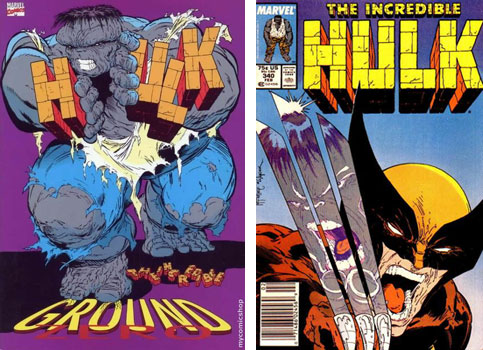
David worked with the brilliant Australian penciler Dale Keown (creator of the Pitt), and the duo helped make the Gray, and Green Hulk appealing to new fans. At the same time they never insulted the continuity for older readers. One of Mr. David’s greatest contributions was introducing the Maestro. The stories with the Abomination, the Juggernaut, and other heavy-hitters were amazing, but he wanted the Hulk to have a rival that was his superior in every way. An older, wiser, and stronger version of the Hulk from the distant future was what he came up with. After all, the only monster that actually stood a chance against the Hulk was… himself. The first appearance of this character was in the 1992 series called Future Imperfect (which was pencilled by George Perez). It was such a hit that the Maestro became an important part of canon, appearing in comics, but also animation, and video games for over 30 years.
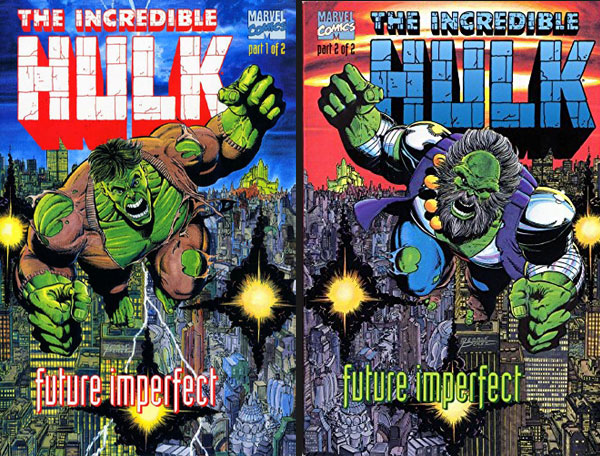
The Maestro was a brilliant design, however I would not consider him to be the Hulk’s greatest rival. Nor would I think of Thunderbolt Ross (in any form) as his greatest opponent. I would reserve that honor to the Leader. The Leader, also known as Samuel Sterns, first appeared in Tales to Astonish #62, way back in December 1964. He was a simple-minded janitor that was exposed to gamma rays during a work accident. He opened a drum of toxic waste because he thought it might have something that he could steal. Instead of dying from radiation poisoning he mutated. He turned into a genius rivaling the most brilliant minds in the Marvel Universe. His skin turned green similar to the Hulk, and other gamma-powered characters. His skull also grew to grotesque proportions. He developed awesome mental powers, including telekinesis, and mind control, on top of his inventing proficiency.
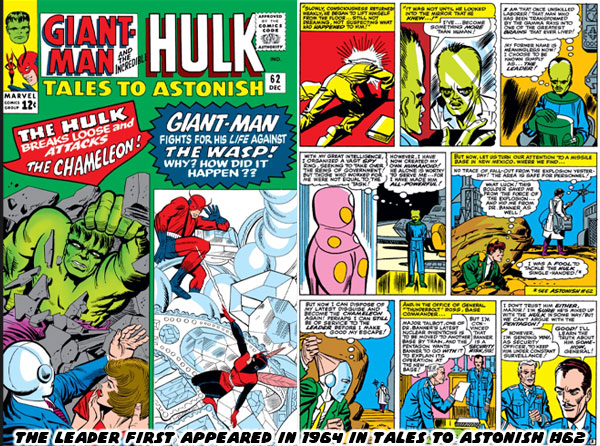
Most Hulk fans, myself included believe that the Leader was actually a chance to reboot the Hulk’s original mutated opponent. In the first issue of the Incredible Hulk from May 1962 there was a Russian spy that was transformed when he tried to recreate the conditions that changed Banner. Instead of growing massively powerful the scientist turned into a twisted version of his former self, with an enormous skull. The first Gargoyle, Yuri Topolov, was created by Stan Lee and Jack Kirby. A few years later the Leader was created by Stan Lee, and Steve Ditko. This formula of mutating spies for the Hulk to battle even applied to the Abomination, previously known as Emil Blonsky. The different looks, and powers of each character was explained as a psycho-physical manifestation of gamma mutation. Their subconscious self actually determined how they would appear to the world. Emil was an abusive husband, and a cruel manipulator. Of all the enemies he was the one that was truly a monster on the inside, and out. That was why he looked like a nightmarish beast when he transformed. The Leader was aware that people thought Sam Sterns was a dummy, but subconsciously he wanted to make everyone feel dumb. Thus he gained a massive brain. Yuri was already intelligent, but thought himself superior to his western rivals. His conceited nature was as ugly as the Gargoyle.
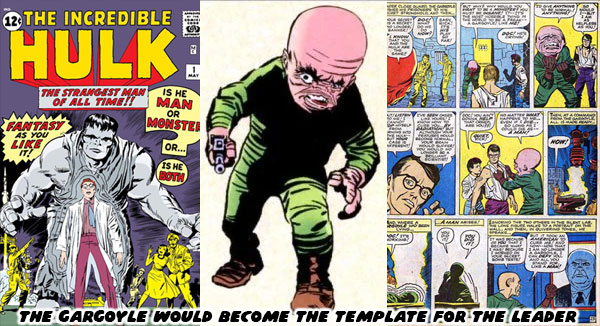
The Gargoyle would be used less, and less as the years went on. His most notable contribution to pop culture happened decades after his debut. In the Incredible Hulk animated series from 1996 he was voiced by Mark Hamill. Hamill was famous for playing Luke Skywalker in the Star Wars films, but for an entire generation his voice work was even better known. Hamill gained a massive following in cartoon circles when he started voicing the Joker for the Batman Animated Series in 1992. In the cartoons the Gargoyle was a subordinate to the Leader, voiced by character actor Matt Frewer. He first gained fame by playing the digital character Max Headroom. The Hulk animated series melded classic plots from the early era of the comics, plus newer designs that had been featured during the Peter David run. It managed to present the lore of the comics fairly well, and explained how the gamma mutations worked to newer fans. It summed up the obsession that the Leader had with the Hulk. He felt superior to Banner in every regard, except for his body, which lacked the strength, and resilience of the Hulk. He felt that he needed to possess the body in order to prove he was the ultimate being.
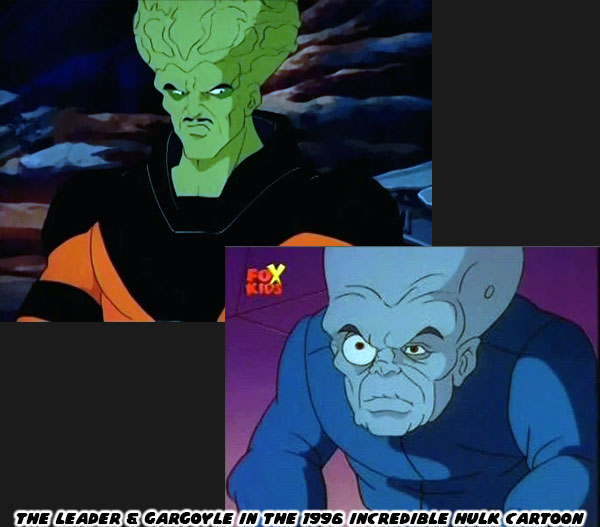
Like most comic book characters the Leader, and Gargoyle underwent some design changes over the years. Early on the Gargoyle had a large deformed head, with a relatively proportional human body. His frame became diminished, and twisted in later versions. His features made grotesque, and impish. The version featured in the animated series more or less defined his modern appearance. The Leader was traditionally seen with a long vertical head, and average build. In canon his body was covered in sores, and he wore a special uniform to allow him to function without pain. He was upset with his frail body, and expected that the perfect mind should be supported by a powerful physique. His look evolved early in the Peter David run. I believe it was Todd McFarlane (before Spider-Man, and Spawn fame) that gave him a new look. He figured that if his brain were to expand then it should have two massive hemispheres, rather than grow straight up. It made sense to me, although many fans were split on the new look. The comics even referred to him as “Jiffy Pop” head,
after the popular way to make popcorn before microwavable bags.
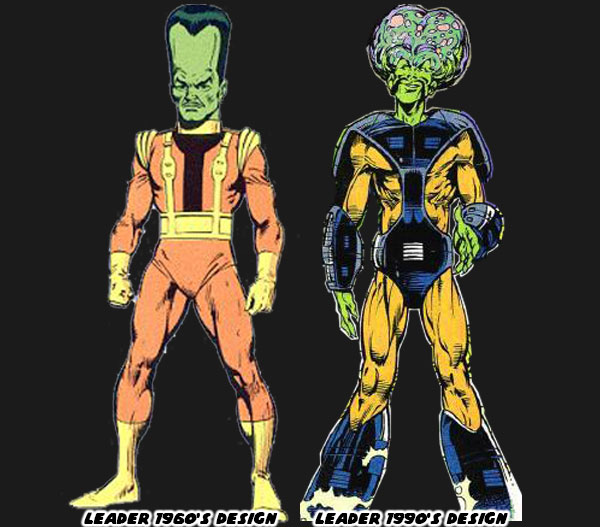
Different iterations of the Leader would appear in comics, and animation. Sometimes the designers would strike a middle ground between the classic look, and the Jiffy Pop form. The Ultimates version of the Marvel U, a sort of retelling of the classic characters in a more contemporary setting influenced the presentation of the live action movies. In that continuity the Leader was a British Special Forces officer named Peter Wisdom. He experimented on himself to save his program, and also in an attempt to become a super soldier. He did gain mind control powers, and telekinesis, but also ended up wheelchair bound. His brain was so big that his neck couldn’t support it. He required a brace in order to keep his head upright. This macabre look was incorporated into some of the latter designs of the traditional Marvel comics. The Leader had a mind literally big enough to figure out every way to take on the Hulk, and have backup plan, after backup plan that even Thunderbolt Ross couldn’t even contemplate.
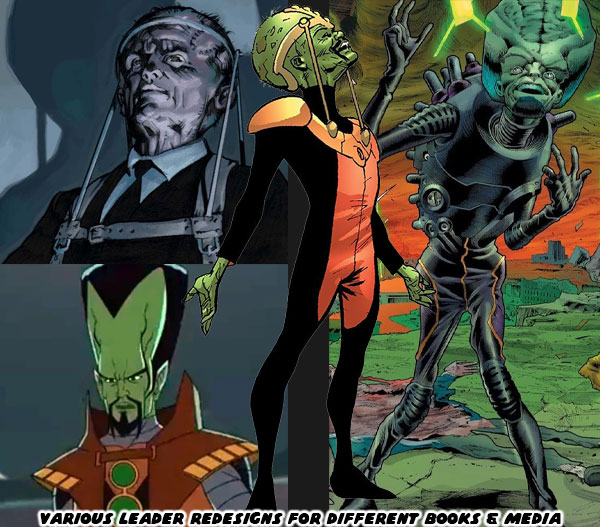
Tony Stark invented power armor light years ahead of anything else on Earth. Yet his biggest rival dressed in robes, and used 10 magic rings that science could not explain. The Mandarin’s powers came from the time of mysticism, and superstition, millennia before science had cracked the atom. The Mandarin was determined to rule the world, and in order to do so he had to destroy Stark, and his precious technology. The Hulk on the other hand could beat any conventional weapon, or other form of technology by sheer force. He had fought Iron Man on numerous occasions. Each time the monster took apart Iron Man like a tin can, including the fabled “Hulkbuster” armor. The Leader made sense in the tradition of great Marvel villains. He was so unlike the Hulk in every way that he was destined to be the ultimate rival. He was able to defy the Hulk by using powers that Banner did not possess. It was his awesome mental abilities, and not brute strength that would challenge Banner, and the Hulk.
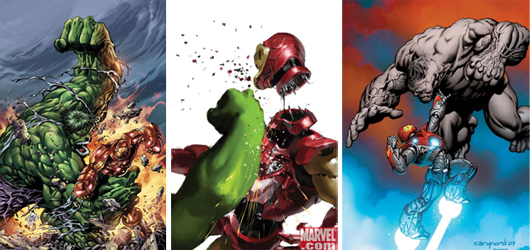
The Leader was another example of the asymmetric enemies that I previously discussed. Despite his frail appearance the Leader was actually a dangerous character. He didn’t even need to know how to throw a punch. His ability to use mind control on individual, and even groups of people was scary enough. If he was mortally wounded he seemed to have the ability to resurrect himself as well. He was a relentless villain that could hunt the Hulk with more vigor than even Thunderbolt Ross. There was a certain logic to his design that made sense in the context of the Marvel universe. I will talk about that in the next blog. Until then I want to know if you have a favorite Hulk villain, or any villain in general. Tell me about it on the comments section. As always if you would like to sponsor me
please visit my Patreon page and consider donating each month, even as little as $1 would help make better blogs and even podcasts!




















No comments:
Post a Comment